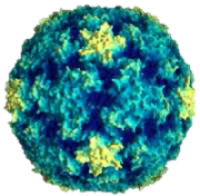
General Information
Rhinoviruses are members of the Picornaviridae family, which includes human pathogens such as enterovirus and hepatovirus. Rhinovirus is a non-enveloped virus that is the most common cause of the common cold. It may also cause some sore throats, ear infections, and sinus infections, and to a lesser degree, pneumonia and bronchitis.
The incidence of these infections is higher in the autumn and winter, with most infections occurring between September and April. The seasonality may be due to the start of the school year and more people spending time indoors, increasing proximity with each other and the chance of transmission of the virus.
Significance
There are over 62 million annual occurrences of the common cold in the United States according to the National Center for Health Statistics. Common colds are the main reason that children miss school and adults miss work. Adults have an average of 2-3 colds per year, and children have even more.
More than 200 different viruses are known to cause the common cold; however, the majority of these are caused by rhinoviruses, followed by coronaviruses, influenza virus and adenoviruses.
More than any other illness, rhinoviruses are associated with the common cold. Rhinoviruses are estimated to be the culprit for about 35% of these cases. There are more than 100 distinct rhinovirus types which makes developing a vaccine against rhinoviruses difficult. Most rhinoviruses seldom produce serious illness and are mainly limited to the upper respiratory tract. In some cases, it may cause complications that lead to ear or sinus infections. In higher risk populations, such as infants, the elderly or immunocompromised, it may also lead to asthma, chronic bronchitis and serious lower respiratory tract; however, most of the infections are mild and self-limited.
Symptoms
Infection occurs rapidly. The incubation period is 12-72 hours, and most people will experience symptoms within 2-3 days of infection. Symptoms generally persist for 7-14 days.
The main signs and symptoms include:
- Sore throat
- Runny nose (nasal discharge)
- Nasal congestion
- Sneezing
This may be accompanied by a mild fever, headache, muscle ache or weakness, cough, fatigue and loss of appetite.
In some cases, especially among infants, the elderly, and the immunocompromised, complications may arise, including ear and sinus infections, asthma, chronic bronchitis, and lower respiratory tract infections.
Transmission
The rhinovirus received its name because “rhino” means nose, the location where the virus typically infects. Rhinoviruses are spread easily through person-to-person contact. The virus is spread by direct contact with aerosols produced when an infected person coughs or sneezes (respiratory secretions) or through contact with contaminated surfaces where you pick up the virus on your hands and later touch your eyes, nose or mouth.
Rhinoviruses are quite stable and can survive a few hours on an inanimate objects, which increases the risk it can be picked up by the hand and later be transferred to the nose, eyes or mouth. The risk of transmission can be increased in schools or day cares where a child with a runny nose transfers secretions to hands, tables, toys or other surfaces which are subsequently touched by other children.
Treatment
There is no cure for a cold. Rhinovirus infections are usually mild and self-limiting, so treatment is generally focused on relief of symptoms and prevention of complications. The typical course of therapy includes:
- Rest
- Hydration (plenty of fluids)
- Keeping head at 45° angle
- Comfortable surroundings, including temperature and adequate humidity to relieve and sooth irritated nasal and throat passages
Over-the-counter medicines, such as antihistamines, nasal decongestants, and may help ease the symptoms, but won’t make a cold go away any faster. It is important to read label and use instructions for any medications, and use them as directed. It is recommended that young children do not use these medications without doctor approval.
It is important to note that antibiotics will not help you recover from a cold. They do not work against viruses, and they may make it harder for your body to fight future bacterial infections or cause other complications if you take them unnecessarily.
Prevention
There are no vaccines available against rhinovirus due to the large number of serotypes. The best way to prevent rhinovirus infection is to:
Also, when possible, avoid close contact with people who have colds or other upper respiratory infections.
- Wash hands often
Scrub hands with soap and water for at least 20 seconds, and help young children do the same. If soap and water are not available, use an alcohol-based hand sanitizer. Viruses live on your hands, and regular hand washing can help protect you from getting sick. Wash your hands after coughing, sneezing or blowing your nose. - Use respiratory hygiene/cough etiquette
Move away from people before coughing or sneezing. Cough or sneeze into a tissue then throw it away, or cough or sneeze into your upper shirt sleeve, completely covering your mouth and nose - Avoid touching your eyes, nose, and mouth with unwashed hands
Viruses can enter your body this way and make you sick. - · Limit contact with infected people
Infected people can spread viruses that cause the common cold through close contact with others. Avoid close contact with others, such as hugging, kissing, or shaking hands if you are sick, and stay home, so you don’t infect others. - Frequently clean and disinfect
Disinfect frequently touched surfaces and objects such as doorknobs, table tops and toys
Cleaning and Disinfection
Diligent and frequent cleaning and disinfection of environmental services is a key component in a comprehensive “respiratory illness” prevention strategy. Rhinovirus is susceptible to several Diversey disinfectants
See table of recommended disinfectants in the PDF link below.

